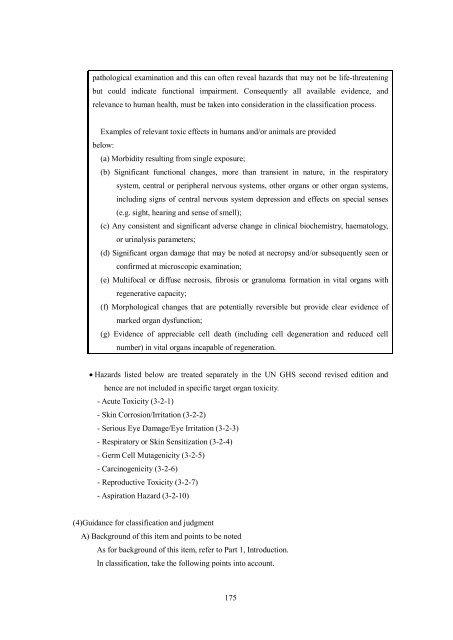GHS Classification Guidance for the Japanese Government
GHS Classification Guidance for the Japanese Government
GHS Classification Guidance for the Japanese Government
Create successful ePaper yourself
Turn your PDF publications into a flip-book with our unique Google optimized e-Paper software.
pathological examination and this can often reveal hazards that may not be life-threatening<br />
but could indicate functional impairment. Consequently all available evidence, and<br />
relevance to human health, must be taken into consideration in <strong>the</strong> classification process.<br />
Examples of relevant toxic effects in humans and/or animals are provided<br />
below:<br />
(a) Morbidity resulting from single exposure;<br />
(b) Significant functional changes, more than transient in nature, in <strong>the</strong> respiratory<br />
system, central or peripheral nervous systems, o<strong>the</strong>r organs or o<strong>the</strong>r organ systems,<br />
including signs of central nervous system depression and effects on special senses<br />
(e.g. sight, hearing and sense of smell);<br />
(c) Any consistent and significant adverse change in clinical biochemistry, haematology,<br />
or urinalysis parameters;<br />
(d) Significant organ damage that may be noted at necropsy and/or subsequently seen or<br />
confirmed at microscopic examination;<br />
(e) Multifocal or diffuse necrosis, fibrosis or granuloma <strong>for</strong>mation in vital organs with<br />
regenerative capacity;<br />
(f) Morphological changes that are potentially reversible but provide clear evidence of<br />
marked organ dysfunction;<br />
(g) Evidence of appreciable cell death (including cell degeneration and reduced cell<br />
number) in vital organs incapable of regeneration.<br />
Hazards listed below are treated separately in <strong>the</strong> UN <strong>GHS</strong> second revised edition and<br />
hence are not included in specific target organ toxicity.<br />
- Acute Toxicity (3-2-1)<br />
- Skin Corrosion/Irritation (3-2-2)<br />
- Serious Eye Damage/Eye Irritation (3-2-3)<br />
- Respiratory or Skin Sensitization (3-2-4)<br />
- Germ Cell Mutagenicity (3-2-5)<br />
- Carcinogenicity (3-2-6)<br />
- Reproductive Toxicity (3-2-7)<br />
- Aspiration Hazard (3-2-10)<br />
(4)<strong>Guidance</strong> <strong>for</strong> classification and judgment<br />
A) Background of this item and points to be noted<br />
As <strong>for</strong> background of this item, refer to Part 1, Introduction.<br />
In classification, take <strong>the</strong> following points into account.<br />
175
















